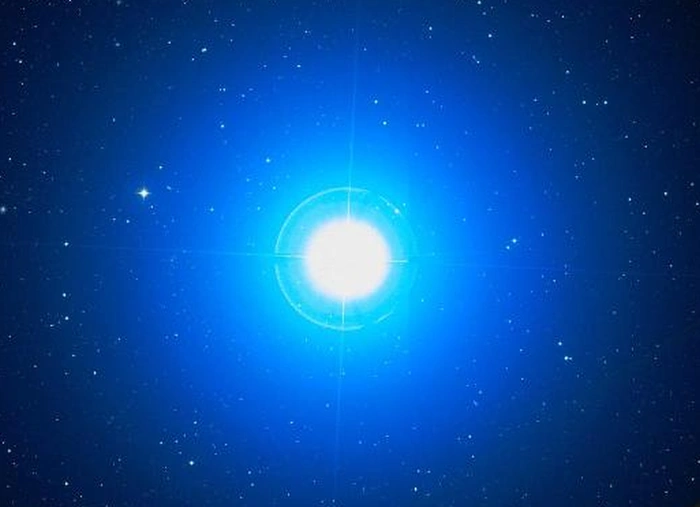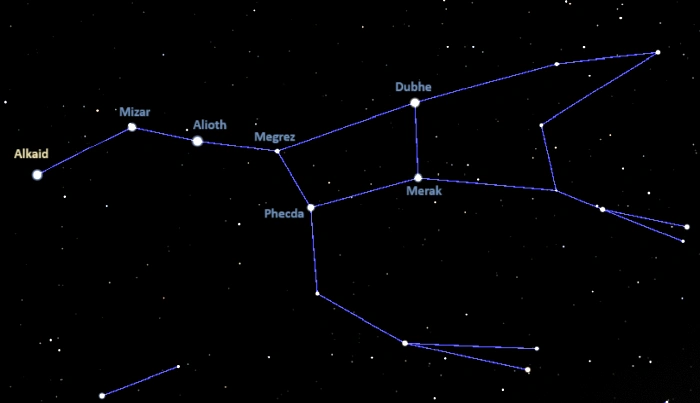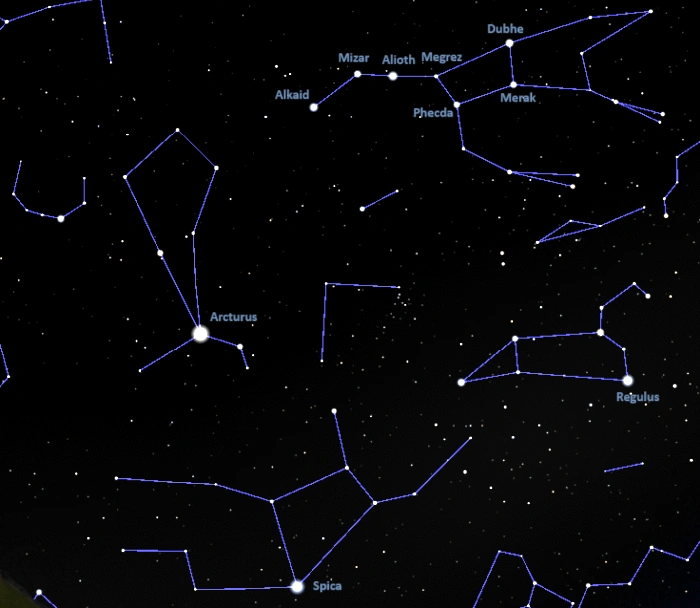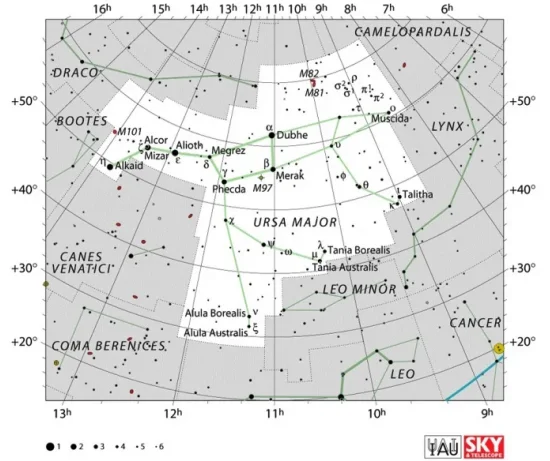Alkaid, Eta Ursae Majoris (η UMa), is a blue main sequence star with an apparent magnitude of 1.86. It lies at a distance of 103.9 light years from Earth in the constellation Ursa Major. It is the third brightest star in the constellation, after Alioth and Dubhe.
Alkaid is the easternmost star of the Big Dipper. It forms the Dipper’s handle and the tail of the Great Bear with its bright neighbours Mizar (ζ UMa) and Alioth (ε UMa). Megrez (δ UMa), Phecda (γ UMa), Dubhe (α UMa) and Merak (β UMa) form the Dipper’s bowl.
Star type
Alkaid is a young star of the spectral type B3 V. It is a hot blue main sequence star that still fuses hydrogen into helium in its core. It has an estimated age of only 10 million years and is considerably younger than the other Big Dipper stars.
Alkaid has 6.1 times the Sun’s mass and 3.4 times its radius. With an estimated temperature of 15,540 K, it is about 594 times more luminous than the Sun. It has an absolute magnitude of -0.67.

Alkaid (Eta Ursae Majoris), image credit: ESO/Digitized Sky Survey 2 (CC BY 4.0)
Alkaid is a fast spinner, with a projected rotational velocity of 150 km/s. The high rotational velocity is giving the star an oblate shape, with flattening at the poles and an equatorial bulge.
Like all fast-spinning stars, Alkaid is an example of gravity darkening. The star’s poles are hotter and brighter than the equator because they are closer to the centre of mass. They also have higher surface gravity. The bright Vega in the constellation Lyra, Achernar in Eridanus, Regulus and Denebola in Leo, and Spica in Virgo are other well-known examples of gravity darkening, as are Alkaid’s Big Dipper neighbours Megrez and Phecda.
Even though it is still a very young star, Alkaid will evolve quickly due to its high mass. B-type stars have pretty short lives. Alkaid is expected to burn through its supply of fuel in less than 100 million years and start evolving into a giant. It will eventually shed its outer layers to form a planetary nebula and slowly fade away as a white dwarf for billions of years. The stellar remnant will have a mass of about 0.85 solar masses.
Facts
Alkaid is the third brightest star in the constellation Ursa Major, after Alioth and Dubhe. It is on average the 38th brightest star in the night sky. It is about as bright as the white bright giant Sargas (Theta Scorpii) in the constellation Scorpius and orange giant Avior (Epsilon Carinae) in Carina.
Alkaid is only slightly fainter than Regor (Gamma Velorum) in Vela, Wezen (Delta Canis Majoris) in Canis Major, and the blue giant Kaus Australis (Epsilon Sagittarii), the brightest star in Sagittarius. It outshines Menkalinan (Beta Aurigae) in Auriga, Atria (Alpha Trianguli Australis) in Triangulum Australe, and Alhena (Gamma Geminorum) in Gemini.
Alkaid forms the Big Dipper with Mizar (Zeta Ursa Majoris), Alioth (Epsilon Ursae Majoris, Megrez (Delta Ursae Majoris), Phecda (Gamma Ursae Majoris), Dubhe (Alpha Ursae Majoris), and Merak (Beta Ursae Majoris). Also known as the Saucepan, the Plough and the Great Wagon, the Big Dipper is one of the brightest and most recognizable asterisms in the northern celestial hemisphere. Six of its seven stars (all except Megrez) shine at second magnitude.

Big Dipper stars, image: Stellarium
Alkaid and Dubhe are the only Big Dipper stars that are not members of the Ursa Major moving group, a stellar association that includes most of the brightest stars in Ursa Major and many stream members in other constellations. These include Adhafera (Zeta Leonis) in the constellation Leo, Menkalinan (Beta Aurigae) in Auriga, Alphecca (Alpha Coronae Borealis) in Corona Borealis, Zhou (Beta Serpentis) in Serpens, Skat (Delta Aquarii) in Aquarius, and Gamma Leporis in Lepus.
The members of the Ursa Major association share common velocities and proper motion because they formed in the same molecular cloud at about the same time. If Alkaid and Dubhe belonged to the group, the Big Dipper asterism would stay mostly unchanged over time. As they do not and are moving in opposite directions, the asterism will disperse in the next several tens of thousands of years.
Alkaid is the second most distant Big Dipper star, after Dubhe, which lies 123 light-years away. With a mass of 6.1 solar masses, a temperature of 15,540 K and a luminosity of 594 solar luminosities, Alkaid is by far the hottest, most massive and most luminous of the seven Dipper stars. With a radius of 3.4 solar radii, it is the third largest, after Dubhe (26.85 solar radii) and Alioth (4.29 solar radii). Even though it has a size comparable to Phecda’s (3.385 solar radii), it is much more massive. Phecda has a mass of 2.412 solar masses.
Since 1943, Alkaid has been used as a spectral standard for its class (B3 V) in the Morgan–Keenan (MK) system of stellar classification. The star’s spectrum is used as a stable anchor point used to classify other stars. The other spectral standard in this class is the slightly fainter and older Haedus (Eta Aurigae).
Alkaid’s brightness and relative proximity to Earth have made the star a frequent object of study. However, no companion stars or planets have been detected orbiting the star to date.
Alkaid is one of the three navigational stars in Ursa Major. The other two are the brighter Alioth and Dubhe. These stars have a special role in the field of celestial navigation because they are very bright and easy to identify.
Even though Alkaid is the third brightest star in Ursa Major, it has the designation Eta Ursae Majoris. This is because the German uranographer Johann Bayer, who catalogued the stars and assigned Greek letters next to Latin genitives of constellation names in his star atlas Uramonetria (1603), did not follow the exact order of brightness, but used magnitude class instead.
Bayer assigned the Greek letters to Ursa Major’s brightest stars going from west to east. This is why Dubhe, the westernmost (and second brightest) star has the designation Alpha Ursae Majoris, while Alioth, the constellation’s brightest star, was given the designation Epsilon. As the easternmost second-magnitude star, Alkaid got the designation Eta.
In medieval astrology, Alkaid was one of the 15 Behenian fixed stars. These stars were believed to be a source of astrological power and used in alchemy for magical applications. Alkaid was linked with Venus and the Moon and associated with magnet and succory, which were used in rituals and talismans to bring out the star’s influence.
Name
The name Alkaid (pronunciation: /ælˈkeɪd/) is derived from the Arabic phrase qā’id bināt naʿsh (Ka’id Banat al Na’ash), meaning “the leader of the daughters of the bier.” The word Alkaid itself means “the leader.” The name was traditionally also spelled Elkeid, Alcaid, Alchayr, Alcaide, Ackair, Ackiar, Alcatel, and Al Ka’id.
In ancient Arabic astronomy, the stars of the Big Dipper symbolized a funeral procession. The stars that form the Dipper’s handle – Alkaid, Mizar and Alioth – represented the mourners, while the stars of the Dipper’s bowl – Megrez, Phecda, Dubhe and Merak – represented the coffin or bier.
Alkaid’s other traditional name, Benetnasch (pronunciation: /ˈbɛnɛtnæʃ/ ), meaning “the leader of the daughters of the bier” or “the chief of the mourners”, is derived from the same phrase. It was also spelled Benenaim, Benenacx, Benenazc, Bennenatz, Benat Elnanschi, Benenath, and Beninax.
The International Astronomical Union’s (IAU) Working Group on Star Names (WGSN) officially approved the name Alkaid for Eta Ursae Majoris on June 30, 2016.
The Chinese know Alkaid as Běidǒuqī (北斗七) the Seventh Star of the Northern Dipper (a Chinese asterism that corresponds to the Big Dipper). The star was historically also called Yáoguāng (瑤光), the Star of Twinkling Brilliance.
The Japanese and the Koreans know Alkaid as Hagunsei and Mukokseong (“the military breaking star” or “most corner star”). Both names have their origins in ancient China.
In Hindu mythology, Eta Ursae Majoris is associated with Marīci, one of the Saptarishi (the Seven Sages), the son of Brahma and the grandfather of the Hindu deities known as the Asuras and the Devas.
Location
Alkaid is very easy to find because it is part of one of the most familiar asterisms in the night sky. It is the leftmost star of the Big Dipper’s handle, or the star that appears the furthest from the Dipper’s bowl. It marks the tip of the Great Bear’s tail.

The location of Alkaid (Eta Ursae Majoris), image: Wikisky
The stars of the Big Dipper’s handle can be used to find Arcturus in the Boötes constellation, the brightest star in the northern sky, and Spica, the brightest star in the constellation Virgo. Following the arc of the Dipper’s handle away from the bowl leads first to Arcturus and then to Spica. These are the brightest stars along the imaginary curved line.

The Big Dipper, Arcturus, Spica and Regulus, image: Stellarium
Alkaid is located in the vicinity of several bright deep sky objects. The Pinwheel Galaxy (Messier 101) appears above the Big Dipper’s handle. It forms a triangle with Alkaid and its neighbour Mizar, the middle star of the Dipper’s handle.
Two other famous galaxies lie just below the handle, in the area between Alkaid and Cor Caroli, the brightest star in the constellation Canes Venatici. These are the Whirlpool Galaxy (Messier 51) and the Sunflower Galaxy (Messier 63).
The Cat’s Eye Galaxy (Messier 94) and Messier 106 appear in the same region of the sky. The Cat’s Eye Galaxy forms a triangle with Cor Caroli and Chara (Alpha2 and Beta Canum Venaticorum), and M106 can be found by extending a line from Dubhe through Phecda in the Big Dipper.
The Pinwheel Galaxy (M101) is located in Ursa Major, while the other galaxies – M51, M63, M94, and M106 – all lie in the neighbouring Canes Venatici.

Deep sky objects near the Big Dipper’s handle, image: Stellarium
Constellation
Alkaid is located in the northern constellation Ursa Major. The Great Bear is the third largest constellation in the sky, after Hydra and Virgo, and the largest of all northern constellations. It occupies 1,280 square degrees of the northern sky. The brightness and familiarity of the Big Dipper asterism make Ursa Major one of the most identifiable constellations in the northern celestial hemisphere.
Ursa Major is one of the Greek constellations, catalogued by the astronomer Ptolemy of Alexandria in his Almagest in the 2nd century CE. In ancient Greek lore, it is associated with Callisto, a nymph who caught Zeus’ eye and was transformed into a bear by his wife Hera.

Ursa Major constellation map by IAU and Sky&Telescope magazine (Roger Sinnott & Rick Fienberg) (CC BY 3.0)
Notable stars in the Great Bear include the red dwarf Lalande 21185, the fourth closest star system to Earth (after Alpha Centauri, Barnard’s Star and Wolf 359), the yellow Sun-like star Chalawan (47 Ursae Majoris) and orange dwarf HIP 57274, each with three orbiting exoplanets, and the variable contact binary star system W Ursae Majoris.
Other interesting stars in the constellation include the orange giants Dubhe (Alpha Ursae Majoris) and Psi Ursae Majoris, the A-type stars Alioth (Epsilon Ursae Majoris), Merak (Beta Ursae Majoris), Phecda (Gamma Ursae Majoris), Megrez (Delta Ursae Majoris), Mizar (Zeta Ursae Majoris), and Alcor (80 Ursae Majoris), and the G-type bright giant Muscida (Omicron Ursae Majoris).
In addition to the Pinwheel Galaxy (M101), bright deep sky objects in Ursa Major include Bode’s Galaxy (M81), its neighbour the Cigar Galaxy (M82), the barred spiral galaxies M108 and M109, and the bright planetary nebula M97, also known as the Owl Nebula.
The Big Dipper and Ursa Major are circumpolar from most northern locations and can be seen throughout the year. They are particularly prominent in the evening sky in the months of spring.
The best time of the year to observe the stars and deep sky objects of Ursa Major is during the month of April, when the constellation is high above the horizon in the early evening. The entire constellation is visible from locations north of the latitude 30° S.
The 10 brightest stars in Ursa Major are Alioth (Epsilon UMa, mag. 1.77), Dubhe (Alpha UMa, mag. 1.79), Alkaid (Eta UMa, mag. 1.86), Mizar (Zeta UMa, mag. 2.04), Merak (Beta UMa, mag. 2.37), Phecda (Gamma UMa, 2.438), Psi Ursae Majoris (mag. 3.01), Tania Australis (Mu UMa, mag. 3.06), Talitha (Iota UMa, mag. 3.14), and Theta Ursae Majoris (mag. 3.166).
Alkaid – Eta Ursae Majoris
| Spectral class | B3 V |
| U-B colour index | -0.68 |
| B-V colour index | -0.19 |
| Apparent magnitude | 1.86 |
| Absolute magnitude | -0.67 |
| Distance | 103.9 ± 0.8 light years (31.9 ± 0.2 parsecs) |
| Parallax | 31.38 ± 0.24 mas |
| Radial velocity | -13.40 ± 0.6 km/s |
| Proper motion | RA: 121.17 ± 0.15 mas/yr |
| Dec.: 14.91 ± 0.17 mas/yr | |
| Mass | 6.1 ± 0.1 M☉ |
| Luminosity | 594 ± 31 L☉ |
| Radius | 3.4 ± 0.5 R☉ |
| Temperature | 15,540 ± 1,157 K |
| Age | 10.0 ± 2.6 million years |
| Rotational velocity | 150 km/s |
| Surface gravity | 3.78 cgs |
| Constellation | Ursa Major |
| Right ascension | 13h 47m 32.2384185147s |
| Declination | +49° 18′ 47.526505983 ” |
| Designations | Alkaid, Eta Ursae Majoris, η Ursae Majoris, η UMa, 85 Ursae Majoris, Elkeid, Benetnash, Benetnasch, Elkeid, HD 120315, HR 5191, HIP 67301, SAO 44752, FK5 509, GC 18643, GCRV 8142, SKY# 25304, PPM 53742, PLX 3147.00, RAFGL 4916S, BD+50°2027, AG+49 1116, CEL 4281, CSV 101406, GSC 03467-01257, NSV 6450, JP11 2433, IRC +50233, N30 3141, ROT 1999, EUVE J1347+49.2, GEN# +1.00120315, HGAM 626, SV* ZI 1023, TD1 17067, TIC 219033887, WEB 11841, uvby98 100120315, TYC 3467-1257-1, WISE J134732.18+491849.4, UBV 12316, UBV M 19728, IRAS 13455+4933, 2MASS J13473244+4918477, Gaia DR3 1510374147844219904 |